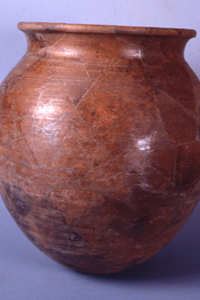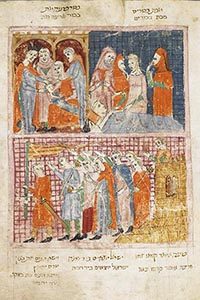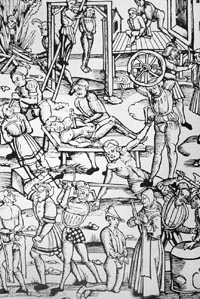

September 2020
Vol. 8, No. 9
Epidemics in Mesopotamia
By Annie Attia
Epidemics have been with us since long before the dawn of history, commonplace phenomena that help us to locate ourselves in the stream of time. Here is what we know about their occurrence in a cradle of civilization, in Mesopotamia.
We may turn to three epistolary archives written in cuneiform on clay tablets. First are those found in Mari, a town on the Euphrates, with documents dating to the 18th century BCE. Then, the archive found in Amarna, in Egypt, dating from the 14th century BCE. Finally, the 7th century BCE letters found in the “library” of the Assyrian king, Assurbanipal, in Nineveh, in northern Iraq.
In those archives, we find many characteristics of “modern” epidemics. Firstly, highly populated places are reservoirs of contamination. The inhabitants of a Mari palace offer a good example. An official writes: “I have had a register drawn for dead people among women weavers, farmers . . . and workhouses and conveyed it to my lord.”
In besieged cities teeming with people seeking shelter, the risk of epidemic spiked, as in Megiddo in today’s northern Israel. Its king requested the help of Pharaoh Akhenaton who resided at Amarna: “Look, the city is consumed by an epidemic and pestilence!” The same situation occurs in the Assyrian empire of the First Millennium: “Ammili’ti[…]is encamped outside the city of Rablâ, plague-stricken.”
The famous “clusters” of contagion punctuating today’s news are also mentioned. Military concentrations were a site of dissemination, as reported in a Mari letter: “I gave 20 small-boats on which to embark the sick. Then, I realized how many sick people there were among them. Those small-boats were not enough for them. So I gave them 2 large-boats for their need.”
Epidemics also spread across large geographic areas. In Mari, a senior official reported:“About the ‘devouring of God’ (…), in Tuttul there is disease, but death is rare. In Dunnum, below Lasqum, there is a heap of dead. Within two days, about 20 people died. The people of Dunnum abandoned (it), escaping to Mt. Lasqum. Muban and Manuhatan, towns in the vicinity of Dunnum, are safe. Dunnum is highly diseased. Mari is safe; the land is safe.” Here we see people escaping the epidemic to take refuge in “healthy” areas, in the mountains. We cannot help but think of city dwellers fleeing today to their country houses.
Amarna’s letters document an epidemic that has spread to the Near East and beyond, from Hittite territory to Egypt. Thus, the king of Cyprus explains to the pharaoh that, because of a plague, his shipment of copper will be less substantial than expected. In Sumur (in modern Syria), this epidemic becomes the pretext not to send donkeys as had been agreed.
The authorities understood the danger of dissemination and organized confinement, not simply in each house, but in entire affected villages and cities. In Mari, an official describes the situation to the king: “God is spreading contagion(striking) in the upper district (…). My lord must give orders that city-dwellers, once they are stricken, ought not enter uninfected towns. The fear is that they will infect the whole land. (…) my lord must stay in Terqa and not proceed toward Saggaratum. The land (there) is infected.”
Similarly, in Amarna’s archives, in a letter sent from Byblos (in modern Lebanon) the inhabitants of a contaminated city are prevented from entering a still safe city: “I will not permit men from Sumur to enter my city. There is a plague in Sumur.” It appears that this ban did not stop the epidemic from reaching Byblos. The denial of its king proves it: “As to his having said before the king, ‘There is a pestilence in the lands.’ (…) There is no pestilence in the lands. It has been over for a long time.”
To prevent contagion from spreading, infected people were confined. The king of Mari tells his wife: “Since she is often at the palace, it will infect the many women who are with her. Now give strict orders: No one is to drink from the cup she uses; no one is to sit on the seat she takes; no one is to lie on the bed she uses, lest it infect the many women who are with her. This is a very contagious infection!”
We see in this letter that epidemics spread by contact: the objects touched by this woman are dangerous. Then, as now, it justifies “social distancing.” It is also through contact that the god causes the epidemic: it is the hand-of-God that strikes the country. There is another metaphor for an epidemic: the god devours the country like an angry ogre.
But how did ancient peoples realize that an epidemic was raging? While our own health officials track the rising numbers of deaths, in Dunnum, the dead were similarly tabulated: “In one day, 10 men and 5 children died.” “Within two days about 20 men of the troops died.”
Mortality rates can be significant, sparing no one: in Mari, men and women, young and old, artisans and peasants, elite or otherwise, even cattle died: “The household of your servant Bahlu-gayim has been wiped out in an epidemic (‘devouring-of-God’); all his children died. No one remains to be responsible for the household.”
In the Amarna archives a plague strikes the royal harem as well as pharaoh’s spouses. When two foreign wives of Pharaoh Amenhotep III died from a plague, his son, Akhenaton requests their replacement. At least this is what Akhenaton wrote to their respective fathers. Was it a true cause or a subterfuge to hide their ill-treatment?
In Mari epidemic is called “hand-of-God” or mûtânu (a word that builds on “death” so perhaps “the deadly one”). It can strike men and animals. But what worries administrators, then as now, were economic shortfalls, and constricted labour supplies.
In a second millennium Babylonian letter, after having carefully discounted the responsibility of Nergal, the god normally assigned to epidemics, an outbreak of plague is attributed to the god Asari. Prayers are produced to appease him. In Larsa (in Babylonia) an extremely touching document describes an epidemic, a prayer-letter (“Appeal to Utu” II), written in Sumerian by the king. In it, he begs the god Shamash to end an epidemic that has plagued his city for seven years. The king describes a city with its wide streets, now empty and silent. He complains that, while enemy troops are unharmed, his young people are affected. In this way, he makes the same association of war and epidemic that occurs in other places and at other times. The king describes himself as a “righteous sufferer.” Unlike his enemies he has been respectful of the deities and has followed carefully religious prescriptions. He does not understand why Shamash, the god of justice, strikes him.
This attitude differs from what emerges from the Mari correspondence. There, divine anger was deemed a capricious penalty, so there were no attempts to uncover what provoked the gods. Instead, officials simply noted the existence of the epidemic and monitored it. In Amarna, as well as in first millennium Assyria, Nergal, god of death and war is responsible for epidemic.
In a prayer from a Hittite sovereign, Murshili II, Egyptian prisoners brought back to Hatti were the origin of the epidemic (“Second Prayer”). Still, Hittite gods allowed this terrible epidemic to take hold. In his “Third Prayer”, the king pleads and begs the gods to end it: “You have allowed a plague into Hatti, (…) so that Hatti has been beaten down severely by the plague (…) This is the twentieth year that people have been dying in Hatti” Murshili II also accuses his father of being responsible for the plague: his sin, a crime, provoked gods’ wrath. Parental guilt is a well-known axiom!
As today, the end of the epidemic is decreed when there are no more deaths. A Mari official writes: “The hand-of-God has eased over the Bank of the Euphrates (Mari territory) and over the entire land. It has not struck again. (Previously), on one day, 10 people and 5 youngsters died, now, the hand-of-God eased and not (even) one person (died) over a single day. God is reconciled. I have had omens taken about (burying) the heap (of dead).” Our approach parallels that of the ancients: they practiced careful de-confinement, carried out purification, (for us, intensive cleaning and disinfection), and expect higher powers (for us, medical science), to agree before feeling out of danger.
In the Amarna or Nineveh archives there is hardly any mention of de-confinement rituals; it was too obvious to be mentioned. There is a feeling that death due to an epidemic or disease was an “ordinary” curse. In letters from the Levant, the epidemic exists, kills, and then stops.
What about the doctors? They occur nowhere. No request for a physician is registered during these horrible moments. In the vast collections of cuneiform medical texts, we find nothing! Yet, exorcisms and rituals were practiced to avoid epidemic outbreaks. Diviners sought to predict their occurrences by reading coded messages in nature or in a sheep’s liver. For example at Mari: “If in the month of Kislev, an eclipse occurs: there will be famine and an epidemic (god will devour).”
This observation must have been so convincing that, more than ten centuries later, the same cues for disaster was recognized in King Esarhaddon’s palace. Once warned, it was enough to practice the proper ritual to avoid the outbreak of the epidemic: “as regards the rites for which the king, my lord wrote to us. In the month of Kislev we practiced (the ritual named): ‘To keep ‘malaria’, plague and epidemic away from man’s home.'”
In compendium of lore called šumma ālu there are these predictions: “[If the soil of the land] exudes black blood, plagues will be regular in that land.” Or (in a broken context): “If a lion kills […] and does not eat, there will be a plague in that city.”
Perhaps this the real lesson to be learned from the diviners’ practices. Observe nature thoroughly and comply with its requirements.
Annie Attia is a physician and editor of the journal Journal des Médecines Cunéiformes.
For further reading:
Beckman, G. 2003. “Plague Prayers to Muršili II” COS 1.60: 156-160
Freedman, S.M. 2017. If a City is Set on a Height: The Akkadian Omen Series Šumma Ālu ina Mēlê Šakin. vol. 3: Tablets 41-63. OPKF 19. Philadelphia: The University of Pennsylvania Museum.
Parpola, S. 1987. The Correspondence of Sargon II, Part I: Letters from Assyria and the West. SAA 1, Helsinki.
Parpola, S. 1993. Letters from Assyrian and Babylonian Scholars. SAA 10, Helsinki.
Moran, W. 1992. The Amarna Letters. Baltimore: Johns Hopkins University Press.
Samson, J. 2017. From the Mari Archives: An Anthology of Old Babylonian Letters. State College: Eisenbrauns PSU Press.
Singer, G.G. 2017. “Beyond Amarna: The ‘Hand of Nergal’ and the Plague in the Levant.” UF 48: 223-248.
Want To Learn More?
 An Affair of Herbal Medicine? The ‘Special’ Kitchen in the Royal Palace of Ebla
An Affair of Herbal Medicine? The ‘Special’ Kitchen in the Royal Palace of Ebla
By Agnese Vacca, Luca Peyronel, and Claudia Wachter-Sarkady
In antiquity, like today, humans needed a wide range of medicines, but until recently there has been little direct archaeological evidence for producing medicines. That evidence, however, also suggests that Near Eastern palaces may have been in the pharmaceutical business. Read More
Passover in the Time of Pandemic
By Alex Joffe
Disease and plague are known from prehistory to the present. They also draw lines between different epochs. Read More
 Witchcraft in Ancient Mesopotamia
Witchcraft in Ancient Mesopotamia
By Daniel Schwemer
Belief in witches was as widespread in Mesopotamia as it was in Europe. Incantation and ritual texts preserved on cuneiform tablets provide a vivid image of witchcraft in second and first millennium Mesopotamia. But a closer look reveals fundamental differences between Babylonian witches and their European counterparts. Read More


